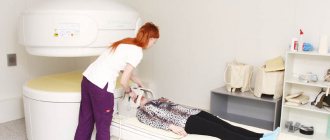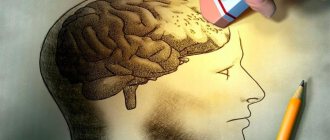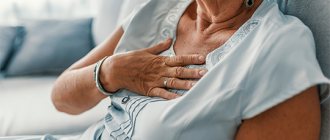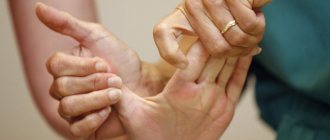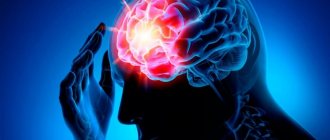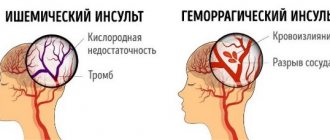The question of whether it is possible to drink alcoholic beverages after a stroke interests many patients. A stroke is an acute disorder of blood circulation in the brain, which is accompanied by pronounced symptoms and causes serious damage to the human brain. The possibility of drinking alcohol during the rehabilitation period can be determined by a neurologist during a consultation. At the Yusupov Hospital you can consult a neurologist and undergo a full examination. Qualified neurologists treat patients, rehabilitation doctors help people restore lost functions after a stroke.
Content:
- Symptoms of alcoholic stroke
- Causes
- Stages of treatment
- Staying in hospital
- Rehabilitation therapy
- Forecasts
Alcoholism causes multiple diseases of internal organs. One of the frequently observed pathologies is impaired cerebral circulation against the background of high blood pressure caused by prolonged alcohol abuse. Alcoholic hemorrhagic stroke occurs after heavy drinking or during a period of alcoholic excess. From the moment the first signs appear, the patient’s condition may improve for some time, but without timely treatment, a sharp deterioration soon follows. Therefore, it is extremely important to recognize the disease in time and literally immediately seek medical help.
Expert opinion on alcohol use after stroke
Cardiologists, together with neurologists and other specialists, fight every day for the health of patients, and I recommend adhering to a healthy lifestyle. In recent years, there has been a decrease in the age of stroke, the reason for this in most cases is the wrong attitude of people towards their own health.
Doctors' opinions regarding alcohol consumption vary. Some experts are of the opinion that drinking alcohol in limited quantities after a stroke is beneficial. Red wine and cognac improve cerebral circulation, which is confirmed by research data. The opposite opinion of neurologists indicates that alcohol in any quantity is harmful to the body, it leads to human degradation. Some doctors consider stroke a hidden consequence of this bad habit.
The neurology clinic employs leading specialists who successfully treat diseases of the nervous system. For each patient at the Yusupov Hospital, an individual therapeutic or rehabilitation complex is developed to achieve maximum effect in treating the disease or eliminating the consequences. Make an appointment with a neurologist at the Yusupov Hospital by phone.
Symptoms of alcoholic stroke
The first signs are lost against the background of withdrawal or intoxication. This condition is called an erased form of alcoholic stroke. Headache, dizziness and nausea do not cause suspicion during this period. But if you suddenly experience severe weakness, increased pain, or vomiting, you should be wary. The manifestations are identical in women and men, at the same time they are accompanied by the following signs of the clinical picture:
- unilateral numbness of the face and limbs;
- vascular cephalgia not controlled by medication;
- lack of coordination, uncertainty of movements, unsteady gait;
- constant weakness and nausea;
- confusion, incoherent slurred speech;
- autonomic disorders - hot flashes, sweating, dry mouth, tachycardia.
The person does not understand and is unable to explain his condition. Loses contact with reality, ceases to navigate in time, makes incomprehensible movements and actions. Sudden mood swings are possible. Such clinical manifestations cannot be ignored.
The severity of stroke symptoms after heavy drinking and the severity of the pathological condition directly depend on the degree and location of the blood flow disturbance, as well as the area of the brain in which it occurred. If at this moment there is no sober person nearby, and those around you are also drunk and cannot provide primary assistance or call a doctor, severe brain disorders develop. Late treatment reduces the positive prognosis and the likelihood of recovery with minimal consequences.
Diet after a stroke has a number of features and rules
In order to regain strength, a person needs energy. The body must use energy correctly. The process of digestion and assimilation also requires strength and resources, so try not to overload your stomach.
- Do not eat hot or cold food. The temperature of food should be close to body temperature.
- Avoid foods containing cholesterol.
- Drink 1.5 - 2 liters of water daily depending on the time of year.
- Eat often, but little by little. Eat slowly and chew every bite of food thoroughly. Remember, the digestion process begins in the mouth.
- Avoid alcohol and nicotine completely.
- Heat foods. This rule is due to the fact that the body requires more time and effort to digest raw food.
Despite a strict diet, food should be varied. With the right approach, every piece of healthy food turns into a brick for restoring the body.
- Meat of lean and dietary varieties restores the nervous system and promotes muscle gain. Eliminate red fatty meat and offal.
- Vegetables, fruits, and greens saturate the body with essential vitamins and microelements. It is recommended to consume at least 400 grams of boiled and baked vegetables daily.
- Low-fat fermented milk products are a source of protein and restore intestinal microflora. It is recommended to consume cottage cheese 2-3 times a week in the form of casseroles. It is forbidden to eat whole and condensed milk, as well as sharp and fatty cheeses, butter, cream and sour cream.
- Low-fat boiled fish should appear on the table of a convalescent person no more than 3 times a week and only boiled or baked. Forget about salted, smoked and fried fish, a product prepared in this way will only cause harm.
- Eating 2-3 eggs per week will help replenish your strength and energy during the recovery period. Eggs can be eaten boiled and in the form of omelettes, adding vegetables and herbs.
Causes
Long-term consumption of alcoholic beverages causes microdamage to the vascular walls, during the restoration of which connective tissue grows and microaneurysms form, thereby reducing elasticity. Increased blood pressure and increased heart rate cause an increase in the volume of blood passed through. Damaged vessel walls are not able to adequately respond to stretching, so rupture and local hemorrhage occur. The surrounding tissues suffer from hypoxia, and massive death of neurons in the affected area occurs. The formed hematoma puts pressure on neighboring structures, causing even greater damage.
There are two pathological types of acute cerebral circulatory disorders:
- hemorrhagic, occurring as a result of rupture of the vascular wall;
- ischemic, occurring due to blockage of a vessel or severe vasospasm, as a result of which the flow of blood to any part of the brain stops.
The condition is preceded by TIA (transient ischemic attacks) - short-term disturbances in brain nutrition, often the first signs of a stroke after heavy drinking. With prolonged toxic effects of alcohol, the body's compensatory capabilities are reduced. The condition after an alcoholic stroke is much more severe than in patients who did not drink alcohol.
Causes
Alcohol has a toxic effect on many tissues of a living organism, and nervous tissue along with the vascular wall is no exception. When drinking alcohol, and especially in large doses, degenerative changes appear in the blood vessels, including the most delicate vessels of the brain. In addition to thinning the vascular wall, alcohol has the property of thinning the blood, which in the event of a hemorrhagic stroke only aggravates the situation and significantly increases the risk of death. When acute hypoxia of the nerve tissues of the brain occurs, the toxic effect on the central nervous system of alcohol and its metabolites aggravates the picture, and the symptoms become pronounced. Alcohol and stroke are the worst combination, leading to a permanent loss of many vital functions and leading to deep disability. The cerebrotoxic effect of ethyl alcohol in combination with acute hypoxia of nervous tissue does not allow reducing the volume of affected tissues due to collateral blood flow and leads to damage to large areas of the brain.
Stages of treatment
If signs of a stroke are detected during or after binge drinking, first aid is as follows:
- call an emergency ambulance;
- avoid further drinking of alcohol;
- calm the victim and limit his movements by placing him in bed until the doctors arrive.
To preserve the integrity of the clinical picture, it is prohibited to give any medications, force someone to drink water, or bring a person to his senses by braking or patting the cheeks. The condition of an acute stroke poses a threat to a person’s life and requires immediate medical, sometimes resuscitation, care.
Consequences of a concussion
You can get a traumatic brain injury at home, at work, in a car accident, or by slipping while walking. The consequence may be a bruise or concussion. These injuries are different: with a bruise, swelling develops; with a concussion, this pathological process is not observed. The following health disorders are diagnosed :
- increased intracranial pressure;
- deterioration of vascular functionality;
- a person experiences attacks of nausea and vomiting;
- the interaction between cells, areas and hemispheres is disrupted;
- problems with vision arise – double vision, “spots” appear;
- functional activity is impaired.
After an injury, a person becomes inhibited and memory problems may occur. A sign of severe injury is loss of physical coordination, concussion with loss of hearing and other senses . The patient, lying motionless in bed, may feel as if his body is in motion.
Staying in hospital
A mandatory condition for treating stroke after heavy drinking is complete abstinence from any alcoholic beverages.
Treatment includes emergency prehospital care and inpatient therapy until vital signs, neurological status and hemodynamics are stabilized. Next, a period of rehabilitation is required.
The following groups of drugs are used in the hospital:
- antihypertensive drugs to normalize blood pressure;
- anticoagulants to reduce blood clotting, reduce the risk of formation and dissolution of existing clots;
- medications to normalize neurological status and vascular drugs to improve blood circulation and nutrition of the brain;
- antioxidants to relieve post-ischemic oxidative stress.
Treatment of alcoholic stroke is long-term, the prognosis is individual in each specific case.
Do no harm: how can you spoil rehabilitation in the first year after a stroke?
After a stroke, the patient’s relatives are confused and scared, and most importantly, they have no idea what exactly and in what order they can do to help their loved one recover.
This often leads to the fact that the first year, the most valuable for recovery, is not used effectively, and precious time for rehabilitation is lost.
So, what to do and what not to do during the first year after a stroke.
Expectation. "When he gets better."
To the question “When to start rehabilitation after a stroke?” there is an answer, and the answer is: on the second day after the stroke.
There is no spontaneous recovery after a stroke. Waiting will achieve nothing; it will only waste valuable time.
Of the first year allotted to us for recovery, the most valuable and most effective are the first 3-4 months. By losing them and waiting for changes, we reduce the chances of regaining function.
photo source: Rossiyskaya Gazeta
Hope for medicine. “Which pill is better after a stroke?”
There are no drugs that restore brain function. We cannot count on injections and IVs; we need to talk about comprehensive recovery by a multidisciplinary team of specialists - physical therapists, psychologists, speech therapists, occupational therapists.
Medications to lower blood pressure, control blood sugar, statins, etc., if prescribed by a doctor, are required to be taken carefully and in a disciplined manner. But this is not a treatment for the consequences of a stroke, but a therapy aimed at controlling chronic diseases and preventing a recurrent stroke.
Exclusion from life and any activity. “After a stroke, you need to lie down and move as little as possible.”
It's a delusion. The patient must be active to the extent that he can, and this range of motion must be helped to expand.
Restrictions on the quality of movement (how exactly you can and should move) exist, and this will be determined by doctors - the attending neurologist and the physical therapy doctor. And if the doctors have determined that it is possible to move, then you need .
And it is very important to make sure that the patient has a reason to move, i.e. he should have different items necessary for each person: a comb, a towel, a toothbrush, a comfortable or favorite mug, glasses, books, crosswords. In general, a person should be surrounded by familiar and necessary small things. And they should also be visible and accessible, so that the patient does not have to ask each time for this or that item. If they are not provided, or placed in such a way that they cannot be seen and taken, then after some time the patient will no longer want to move, he will lie and wait for everything to be brought and “put in his mouth.” This will greatly interfere with recovery from a stroke. But if a person is given a certain amount of independence, he will recover faster and better.
With the assistance of our foundation, a unique simulator room was opened in Kaliningrad, in the medical rehabilitation department of people with central nervous system damage at the Central Clinical Hospital.⠀The room includes a specially designed therapeutic kitchen that will allow patients to adapt to the limitations caused by a stroke.
Everyday skills are trained there: cooking, planting plants and seedlings in anticipation of the summer season. According to specialists from the Kaliningrad Central City Clinical Hospital, the ergoroom will be able to help in the rehabilitation of more than 300 patients per year. Ergotherapy is a mandatory element of rehabilitation after a stroke, allowing the patient to gain the maximum possible independence, taking into account the consequences of the disease. In their work with patients, ergotherapists focus on preparing the patient to independently perform actions that will be needed in everyday life: washing, preparing food, self-care, etc.⠀The Ergoroom project is federal, which means that we equip them in different cities of Russia. You can support our initiative via the link https://www.orbifond.ru/help/, indicating the purpose “Help to specialized organizations”. ⠀Equipping an ergoroom in Kaliningrad and training specialists in the rehabilitation department became possible thanks to donations collected through the Sberbank Together project from Sberbank.⠀#fondorbi #ergoroom #sberbank #poststroke Published by the ORBI Foundation Tuesday, April 30, 2021
The space around a person after a stroke should help him recover, that is, be ergotherapeutic
Massage. “The main (the only means of recovery after a stroke is massage.”
Massage is sometimes used in rehabilitation treatment after a stroke, as an adjunct to physical therapy. Whether it is needed or not, the doctor will decide. But in any case, it is not an independent form of treatment and cannot restore the lost function of movement.
Wrong choice of rehabilitation.
After rehabilitation, a person should not be able to pedal and use exercise equipment, but go to the toilet, get dressed, prepare food for himself, be able to take care of himself or do something around the house, etc. The essence of rehabilitation is not to restore some part of the body, but to restore life. Simulators and devices can be of help during rehabilitation; basically, they make life easier for the doctor and staff, since part of the work is transferred to the mechanism. But rehabilitation does not require mechanisms and computers, but the knowledge and skills of a doctor.
How to avoid making all these mistakes?
The ORBI Foundation understands all the fears associated with stroke. The founders of the fund themselves were in such a situation and acted by trial and error. Therefore, the ORBI Foundation created the “Stroke Help Line 88007075229” program. You can call the line and ask any question you have, even if it seems stupid to you. We will help you with the route of action.
Support the work of the fund
Share
Rehabilitation therapy
After stabilization of the pathological condition and improvement, the patient is prescribed restorative drug treatment, a course of massage and physical therapy, physiotherapeutic procedures, dietary nutrition and adherence to a daily routine. To regain speech, regular classes with a speech therapist-defectologist are necessary.
They use drugs to normalize the functions of the nervous system - Cerebrolysin, Glycine, Piracetam and a complex of vitamins and minerals. If depression and sleep disorders occur, antidepressants are indicated.
Nutrition problems after cerebral stroke
Experts highlight certain problems and features of caring for people who have had a stroke:
- Possible difficulties with chewing and swallowing food;
- if the mobility of the hand is affected, it may be difficult to use a fork or spoon;
- Appetite may worsen, moodiness and selectivity in eating may occur;
- memory impairment is possible - the patient forgets what and when he ate.
- Many patients are prescribed strict bed rest due to the threat of recurrent stroke, general serious condition, and partial impairment of motor functions.
Patients after a stroke need a diet that will help quickly restore lost body functions, while also providing the necessary substances for life (including in cases of impaired swallowing reflex and chewing process).
Forecasts
Repeated strokes occur 2 times more often in those suffering from alcoholism. The mortality rate is almost 50% of the total number of cases. Disability with complete or partial paralysis occurs in 43 patients out of 100 who have had a stroke due to alcohol consumption.
If there are cases of acute hemorrhagic or ischemic circulatory disorders in the family history of an addicted person, it is worth reconsidering your lifestyle and stopping drinking alcohol forever.
Why you shouldn't drink alcohol after a concussion
Traumatic brain injury and the conditions under which it occurs are a stressful situation for any person. Alcohol is a traditional stress reliever for many. They try to dull the uncomfortable and painful state with a glass of cognac or a shot of vodka. Is it possible to drink alcohol if you have a concussion and what are the possible consequences of drinking alcohol after an injury?
Ethanol and its breakdown products, after absorption, enter the bloodstream and enter the brain. These chemicals negatively affect the functioning of the brain and blood vessels. In contrast to the popular belief that blood vessels dilate, they narrow under the influence of psychoactive substances. As a result, brain cells receive less nutrients and oxygen for their vital functions. There are spasms and severe headaches. Taking alcohol during a concussion, a person provokes hypoxia and aggravates his serious physical condition.
As a result of intoxication of the body after drinking alcohol, oxygen starvation of the brain occurs. Severe dizziness occurs and the victim loses consciousness. With severe injuries, convulsions may occur. The reason for these phenomena is the ability of ethanol to agglutinate red blood cells. Under the influence of ethyl alcohol, these blood cells stick together, increase in size, move slowly and clog small vessels . In areas where blood has stopped flowing to the brain, cell death is observed. This leads to impaired brain function. If you drink alcohol during a concussion, the consequences of the injury will become more severe.
To improve brain function, it is necessary to restore normal nutrition to its cells and the elasticity of blood vessels. This requires medication and complete rest. Drinking alcohol slows down the recovery process, and in severe cases, stops it completely. Cigarette smoke, strong tea and coffee have a similar effect. Biologically active substances in their composition stimulate vasoconstriction , which causes spasms. For this reason, not only alcohol is prohibited after a concussion, but also a number of products that are harmful to health. These recommendations must be strictly followed.
Nutrition guidelines for stroke: food, calories, fluid
When developing nutrition for bedridden patients after a stroke, the menu should be as balanced as possible in terms of calories, taking into account age and inactivity, and limited in the amount of table salt (so as not to provoke an increase in pressure). In addition, the food should be light so that there is no overload of digestion, but at the same time the body is provided with all the necessary nutrients. It is also important to ensure that the patient receives a sufficient amount of fluid, proteins with physiological consumption of fats and carbohydrates, which will help prevent thrombosis and the progression of atherosclerosis.
It is also important to know what foods are allowed and prohibited for an elderly person after a stroke. Helpful after a stroke:
- fish (low-fat) and various seafood;
- lean meat, poultry;
- egg white;
- vegetable oils;
- low-fat dairy products;
- dried fruits and nuts;
- dishes made from whole grains (porridge, side dishes);
- fresh fruits, ripe berries;
- fresh, boiled, stewed vegetables;
- a lot of greenery;
- drinking water, green tea, compotes, natural fruit drinks and juices diluted with water.
Not recommended after a stroke:
- fatty foods (lard, fatty meat, lard, bacon);
- black tea or coffee;
- marinades, pickles, spicy dishes;
- roast;
- sweets, candies, chocolate;
- alcohol.
In addition, it is important for patients to have a complete supply of B vitamins, colecalciferol (vitamin D), magnesium, potassium and iron.
And it seems that all these problems can be solved simply by a balanced diet. But the problem is complicated by the condition of people who have suffered a stroke. They often experience serious damage - paresis, problems swallowing food, impaired coordination and other similar consequences. As a result, regular food is not always available to such patients. Moreover, due to the transferred condition, a depressive background often develops, appetite and the desire to make efforts to process the necessary food disappear. As a result, doctors have to use tube feeding (the nutritional mixture is administered through a special tube) or siping.
The second nutrition option - siping - is relevant if the patient is able to swallow on his own, so regular nutrition in combination with specially developed products that cover all the needs associated with useful substances is suitable for him. That is, the patient eats regular food and at the same time drinks drinks rich in beneficial elements. Or he drinks exclusively nutritious mixtures.

